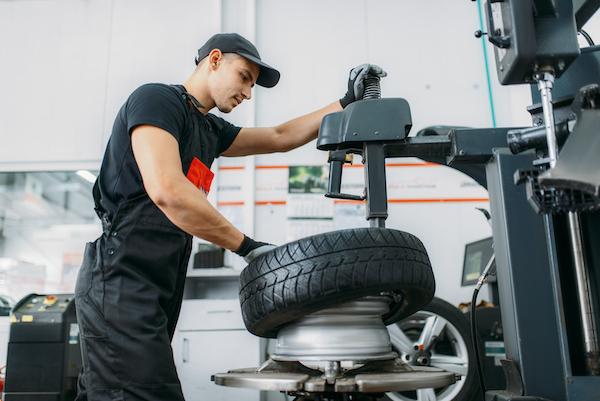Wide Option of Tires Morris IL: Locate the Perfect Suitable For Your Vehicle
Wide Option of Tires Morris IL: Locate the Perfect Suitable For Your Vehicle
Blog Article
Tire Solution: The Impact of Weather
When it comes to making sure optimal efficiency and safety on the road, comprehending the effect of climate conditions on tire solution is vital. In this conversation, we will discover the elaborate partnership between weather problems and tire solution, shedding light on the relevance of weather-specific tire maintenance methods and considerations.
Warm and Tire Efficiency
When subjected to heats, tires experience modifications in performance that can significantly influence car safety and handling. The warmth generated from extended driving or heat problems causes the tire rubber to soften, bring about reduced walk life and boosted wear. As the rubber comes to be softer, the tire's grip when traveling decreases, impacting stopping distances and general grip. In severe instances, too much warmth can even cause tire blowouts, presenting an extreme safety and security threat to the automobile and its owners.
Additionally, high temperature levels can accelerate the procedure of tire aging, triggering the rubber to weaken much more rapidly. This can cause splits, protrudes, and various other types of damage that compromise the structural integrity of the tire. To mitigate the results of warmth on tire efficiency, motorists need to frequently inspect their tire pressure, revolve tires to ensure even wear, and evaluate for any type of signs of damage. Additionally, making use of tires especially created to endure high temperature levels can assist preserve optimum performance and security when driving.
Winter Impacts
Winter problems can have a substantial effect on tire efficiency and safety. As temperature levels drop, tire rubber can solidify, bring about reduced grip on icy or snow-covered roads. In cool weather condition, tires might also shed air stress a lot more quickly, which can influence dealing with and gas efficiency. Furthermore, cold temperatures can trigger tire sidewalls to tense, enhancing the threat of damage from holes or various other roadway hazards.
To reduce the impacts of cool weather on tires, it is essential to regularly check tire pressure and inflate them to the supplier's advised degrees. Making use of winter or all-season tires designed for cool weather condition problems can additionally boost grip and grasp on icy or snowy roadways - tire shop morris. Proper tire maintenance, including routine examinations for wear and damages, ends up being also a lot more crucial during colder months to guarantee optimal performance and security
Rainy Conditions Impact
Tires with damaged footsteps are extra vulnerable to hydroplaning, where a layer of water builds up in between the tire and the road surface, leading to loss of traction. To combat this, motorists should consistently inspect their tires for adequate tread depth and take into consideration investing in tires specifically designed for wet problems.

Snow and Tire Security
When driving in snowy conditions, having the appropriate tires can More Bonuses make a considerable difference in security and efficiency. Wintertime tires are developed with unique rubber compounds and walk patterns to provide far better traction on snow and ice compared to all-season tires.
Along with making use of wintertime tires, it is important to guarantee they are correctly blown up. Cold climate can cause tire stress to go down, impacting grip and handling (morris tire and alignment). Frequently examining and maintaining the right tire stress is vital for ideal efficiency in snowy problems

Weather-Related Tire Maintenance
When confronted with various weather problems, correct tire upkeep comes to be an essential aspect of vehicle safety and security and efficiency. Weather-related tire maintenance incorporates a series of techniques aimed at ensuring ideal tire feature and longevity in different weather condition situations. One key aspect of weather-related tire upkeep is tire pressure law. Rising and fall temperature levels can cause tire stress to vary, influencing traction and gas efficiency. Consistently readjusting and inspecting tire pressure according to manufacturer recommendations is essential for risk-free driving in changing from this source weather condition conditions. Furthermore, tire tread deepness plays a significant duty in managing different weather components. Tires with appropriate tread depth give much better hold on wet or icy roadways, decreasing the threat of hydroplaning or skidding. Examining tire tread frequently and replacing tires when tread wear reaches a specific depth is vital for preserving grip and security in unfavorable climate. By prioritizing weather-related tire upkeep, drivers can improve security, boost lorry efficiency, and prolong the life expectancy of their tires.
Final Thought
In verdict, climate problems have a substantial impact on tire efficiency and security (tire shop morris). From heat influencing tire stress and use to cool climate reducing grip, it is necessary to think about the weather condition when maintaining and utilizing tires.
In this discussion, we will explore the detailed connection in between weather condition problems and tire solution, shedding light on the relevance of weather-specific tire upkeep practices and factors to consider.

Report this page